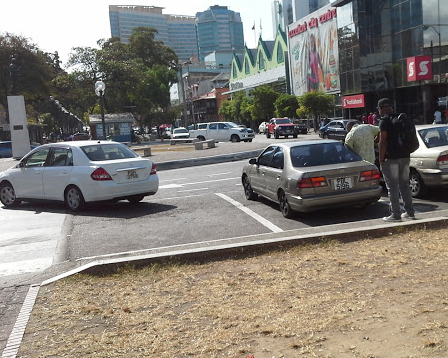Taxi stands where numerous persons have been robbed at night. Taxies can be easily robbed at any time.
Trinidad has one of the highest crime statistics in the
Caribbean. This criminal behaviour is even reflected within the transport
system. In 2014, Trinidad had 2592. Many persons have reported being robbed in
maxies and cars (taxies) travelling in and out Port of Spain. This is not only
limited to the passengers but many maxi and car drivers have reported being
robbed while on their jobs.
These drivers have reported being robbed several times at
knife point and gun point in various areas along the Priority bus route and
different areas of Port of Spain. These drivers often say that it is extremely
dangerous working in certain areas such as the Beethum and Lavintille at night.
They exclaimed that they are not the only target when the maxi’s are being held
at ransom but the passengers are often report being robbed as well.
The Ovearseas Security Advisory Council’s Trinidad and
Tobago 2014 Crime and Safety Report (2014) states individuals have reported
being robbed while travelling in maxies and gypsy taxies (cars). It has also
been reported that sometimes these robberies are done with the collusion of the
driver. Ms. Julisa Willett told us the story of when she was robbed. Ms. Willett
stated that the incident took place late at night while she was travelling home
from an event. She was sitting in a window seat in a maxi and as the maxi haulted
at a traffic light, a car pulled up next to the maxi and a man started to
wrestle with her for her bag through the window. She continued by saying that
the maxi driver never drove off in the mist of the action. In her account she
says “he stood there and let me get robbed.” She believes he was in collusion
with the thief and hence did nothing to help her. Ms. Willett said that the
thief made off with two cellular phones and about $200. 00 she had in her
purse.
As mentioned in Jaffe (2012) believes that crime is more
prevalent in cities because of the economic disparities and discrimination
against ethnic, racial and sexual minorities. Sampson (1986), also supports
this by saying that known determinants of crime rates are inequality, poverty
and racial composition. However,
Trinidad has such a well-integrated plural society and multi-ethnic society
that it is easy for one to say the main cause of the high crime rate in Port of
Spain is economic inequality. Many persons in the city have low income earning
jobs this leads persons having to find creative ways of making money. This may
include criminal activity. As stated in our “Differ faces, Differ places” blog there is racial inequality
in the city of Port of Spain which can play an antagonistic role in crime in
the city.
However, according to local Trinidadian police, the crime
rate has reduced.
Graph
showing Crime Statistics for the Year.
The graph show a steady decline in crime from that January
to February. However, the graph shows that there were n crimes committed in
March and so far for the month of April. This is highly questionable. There may
be a case of a missing data for March and so far for the month of April. Baring
this in mind, we look at the only two months for the year for which is there is
data, January and February.
Nevertheless, one can only hope that crime really is on the
decline and that the streets of Port of Spain are safe for all those who choose
to venture there. Having a high crime rate can deter shoppers and tourist,
making them feel unsafe to venture into the city. More over entrepreneurs and
established business giants may be less inclined to set up businesses in a
crime laden area, hence affecting the business aspect of the city. All in all,
we would like to believe that the city has a declining crime rate as no one wants
to see such a rich city, which such strong cultural routes get a bad
reputation.
Sources:
http://myelearning.sta.uwi.edu/file.php/32678/Jaffe2012-Neoliberalism.pdf


Spelling!!!
ReplyDelete